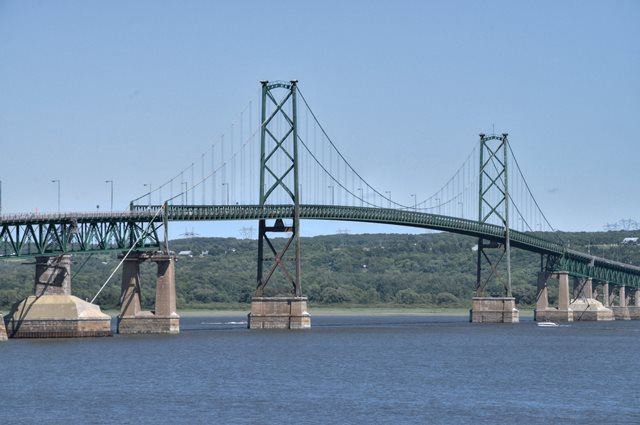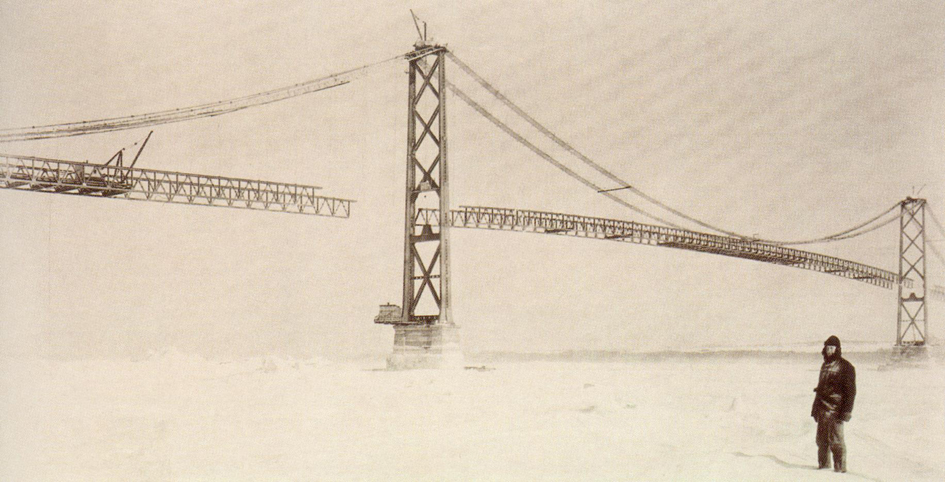We Recommend:
Bach Steel - Experts at historic truss bridge restoration.
Pont de l'Île-d'Orléans (Île d'Orléans Bridge)
Pont de l'Île

Primary Photographer(s): Nathan Holth and Susie Babcock
Bridge Documented: July 10, 2019
QC-368 Over St. Lawrence River (Fleuve Saint-Laurent) (North Channel)
Quebec City (Ville de Québec) and Saint-Pierre-de-l'Île-d'Orléans: Capitale-Nationale, Québec: Canada
Metal Pony Truss Stiffening Wire Cable Suspension, Fixed and Approach Spans: Metal Rivet-Connected Warren Deck Truss, Fixed
1935 By Builder/Contractor: Dominion Bridge Company of Montréal, Québec and Engineer/Design: Monsarrat and Pratley of Montréal, Québec (Charles Nicholas Monsarrat and Philip Louis Pratley)
Not Available or Not Applicable
1,059.0 Feet (322.8 Meters)
5,700.0 Feet (1737.4 Meters)
Not Available
3 Main Span(s) and 35 Approach Span(s)
Not Applicable

View Information About HSR Ratings
Bridge Documentation
This bridge's future is at risk!
Bridge Status: This nationally significant heritage bridge is slated for demolition and replacement!This iconic heritage landmark was the first all-Canadian built long-span suspension bridge, meaning it was designed by Canadian engineers, it was built by Canadian contractors, and it was made from Canadian materials. The bridge was an important source of employment for Canadians during the Great Depression. The bridge was designed by the firm of Monsarrat and Pratley of Montréal, Québec which was run by noted engineers Charles Nicholas Monsarrat and Philip Louis Pratley. This is the earliest of three large bridges that this company designed over several decades. The 1938 Lions Gate Bridge in Vancouver, British Columbia and the 1955 Angus L. Macdonald Bridge in Halifax, Nova Scotia are later suspension bridges built by the same firm. As originally built, all three of these bridges had similar design details including pony truss stiffening, unusual paired suspender cables, and architectural details on the towers (although the later two bridges had an arched detail on the towers over the roadway). Of these three bridges, the Pont de l'Île-d'Orléans is the only one that has not had its historic integrity severely altered by the complete demolition and replacement of the stiffening truss with a stiffening girder. Thus, as both the oldest and least altered of these three masterpiece bridges by Monsarrat and Pratley, this bridge is clearly the most historically significant surviving example. The towers of the bridge rise 70.75 meters above the concrete piers. While the Dominion Bridge Company was the main contractor for this bridge, other firms played a role as well, such as the Eastern Canada Steel and Iron Works of Montréal which was a fabricator for some of the steel on the bridge. Despite its significance, this bridge is at a high risk for demolition and replacement with an ugly cable-stayed bridge.
View Detailed Heritage Report For This Bridge
View Text Only English Translation of Detailed Heritage Report For This Bridge
View Biography of Philip Louis Pratley
View Historical Articles About This Bridge
Above: Shop fabrication of deck truss spans by Eastern Canada Steel and Iron Works of Montréal.
Above: Historical photo showing bridge construction.
Above: Historical photo showing bridge construction.
Above: Historical photo showing bridge construction.
Above: Historical photo showing bridge construction.
Above: Historical photo showing bridge construction.
![]()
Photo Galleries and Videos: Pont de l'Île-d'Orléans (Île d'Orléans Bridge)
Bridge Photo-Documentation
Original / Full Size PhotosA collection of overview and detail photos. This gallery offers photos in the highest available resolution and file size in a touch-friendly popup viewer.
Alternatively, Browse Without Using Viewer
![]()
Bridge Photo-Documentation
Mobile Optimized PhotosA collection of overview and detail photos. This gallery features data-friendly, fast-loading photos in a touch-friendly popup viewer.
Alternatively, Browse Without Using Viewer
![]()
CarCam: Westbound Crossing
Full Motion VideoNote: The downloadable high quality version of this video (available on the video page) is well worth the download since it offers excellent 1080 HD detail and is vastly more impressive than the compressed streaming video. Streaming video of the bridge. Also includes a higher quality downloadable video for greater clarity or offline viewing.
![]()
Maps and Links: Pont de l'Île-d'Orléans (Île d'Orléans Bridge)
Coordinates (Latitude, Longitude):
Search For Additional Bridge Listings:
Additional Maps:
Google Streetview (If Available)
GeoHack (Additional Links and Coordinates)
Apple Maps (Via DuckDuckGo Search)
Apple Maps (Apple devices only)
Android: Open Location In Your Map or GPS App
Flickr Gallery (Find Nearby Photos)
Wikimedia Commons (Find Nearby Photos)
Directions Via Sygic For Android
Directions Via Sygic For iOS and Android Dolphin Browser









